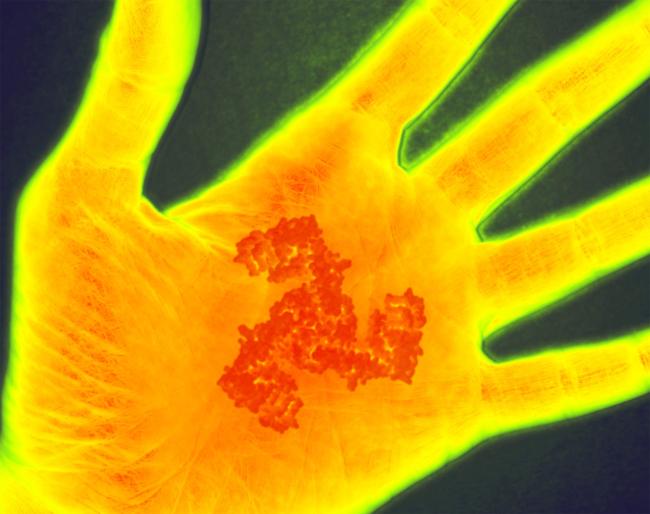How gentle touch can turn painful after injury
October 23, 2018
How gentle touch can turn painful after injury
At a Glance
- Researchers identified a gene that’s needed for gentle touch to turn painful after an injury.
- The study uncovers a possible target for developing precise treatments to relieve the pain caused by cuts, burns, and other skin injuries.

Ever wonder why things that normally feel gentle, like putting on soft shirts, are painful after a sunburn? The skin’s reaction to injury and inflammation can make a normally gentle feeling touch turn painful. This is called tactile allodynia.
PIEZO2 is a “mechanosensitive protein” that responds to mechanical pressure, like pressing your hand against a table. The protein transmits information about touch by sending signals through nerves in the skin to the brain. In previous work, a team led by Drs. Alexander T. Chesler and Carsten Bonnemann at NIH’s National Center for Complementary and Integrative Health (NCCIH) and National Institute of Neurological Disorders and Stroke (NINDS) showed that two patients with mutations in the PIEZO2 gene were unable to feel vibrations and were less sensitive to certain forms of gentle touch. They also lacked a “sixth sense” called proprioception, which determines how your body is positioned in space.
To further investigate the role PIEZO2 plays in touch and pain, Chesler’s team and a second group led by Dr. Ardem Patapoutian at Scripps Research in La Jolla, CA, carried out a series of studies in mice engineered to carry mutations in the Piezo2 gene. In parallel, Chesler and Bonnemann’s team also evaluated four newly identified patients with PIEZO2-deficiency syndrome. The research was supported in part by NINDS and NCCIH. Results were published in two separate papers in Science Translational Medicine on October 10, 2018.
Chesler’s team tested whether genetically removing Piezo2 in mice altered their ability to feel gentle touch or pain. Using an imaging technique to track neuron (nerve cell) activity, they saw that the neurons that lacked functional Piezo2 did not respond to gentle touch or vibration sensations, but still responded to pinching and temperature.
The researchers then tested whether a gentle touch could turn painful after an inflammation response by applying capsaicin (the ingredient that makes chili peppers hot) to the skin of mice. In normal mice, a gentle touch elicits a painful response after capsaicin treatment, but not in the mice lacking Piezo2.
Patapoutian’s group performed experiments in which they used a light-activated gene to turn on Piezo2-expressing neurons in the paws of mice. Shining a light on their paws caused an overexpression of the protein, and the mice flinched and withdrew their paws from the light as though they felt pain. Further experiments also suggested that PIEZO2 may partially mediate the response to pain.
Based on these findings, Chesler’s team tried the capsaicin test in four patients with mutations in the PIEZO2 gene. With participants’ views blocked, the researchers dabbed two creams onto their arms. One was a placebo that had no effect and the other contained capsaicin. Swiping a cotton swab around the capsaicin patch consistently caused control participants to feel pain. Each could correctly identify where the inflammation was even though they couldn’t see their arms. In contrast, participants with the PIEZO2 mutation felt no difference between the areas where capsaicin and placebo had been applied.
“For years scientists have been trying to solve the mystery of how gentle touch becomes painful. These results suggest Piezo2 is the gene for tactile allodynia. We hope that these results will help researchers develop better treatments for managing this form of pain,” Chesler says.
Related Links
- Rare Disorder Reveals Insights Into Touch and Body Awareness
- Discriminating Touch
- Sensing Positive Touch
- Touch Affects Impressions, Decisions
- Merkel Cells Give You a Light Touch
- Pain
- Managing Pain: Moving Beyond Opioids
References
PIEZO2 mediates injury-induced tactile pain in mice and humans. Szczot M, Liljencrantz J, Ghitani N, Barik A, Lam R, Thompson JH, Bharucha-Goebel D, Saade D, Necaise A, Donkervoort S, Foley AR, Gordon T, Case L, Bushnell MC, Bönnemann CG, Chesler AT. Sci Transl Med. 2018 Oct 10;10(462). pii: eaat9892. doi: 10.1126/scitranslmed.aat9892. PMID: 30305456.
The mechanosensitive ion channel Piezo2 mediates sensitivity to mechanical pain in mice. Murthy SE, Loud MC, Daou I, Marshall KL, Schwaller F, Kühnemund J, Francisco AG, Keenan WT, Dubin AE, Lewin GR, Patapoutian A. Sci Transl Med. 2018 Oct 10;10(462). pii: eaat9897. doi: 10.1126/scitranslmed.aat9897. PMID: 30305457.


